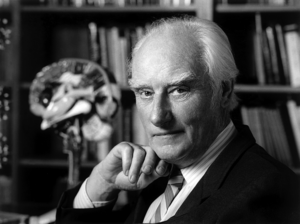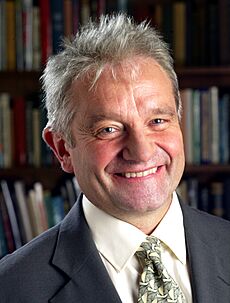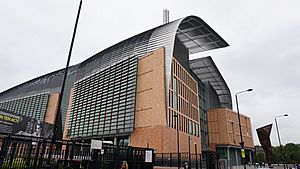Francis Crick Institute facts for kids
 |
|
| Established | 2010 |
|---|---|
| Type | Research institute |
| Registration no. | England and Wales: 1140062 |
| Focus | Medical research |
| Location |
|
|
Chief Executive
|
Sir Paul Nurse |
The Francis Crick Institute is a huge science center in London, United Kingdom. It's a place where scientists study living things to understand diseases. They want to find new ways to treat, diagnose, and prevent illnesses. This includes conditions like cancer, heart disease, and infections.
The institute started in 2010 and opened its doors in 2016. It's a team effort by several big organizations. These include Cancer Research UK, Imperial College London, King's College London, the Medical Research Council, University College London, and the Wellcome Trust.
With 1,500 staff, including 1,250 scientists, it's one of the largest biomedical labs in Europe. The institute is named after Francis Crick. He was a famous scientist who helped discover the structure of DNA. He won the Nobel Prize in Physiology or Medicine in 1962 for this amazing discovery.
Contents
How the Institute Started
Early Ideas for a New Research Center
Back in 2003, the Medical Research Council decided its main research center, the National Institute for Medical Research (NIMR), needed a new home. They looked at many different places. One idea was to move it to University College London in 2005, but this plan didn't happen.
In 2006, a report called the Cooksey Review was published. It looked at important health research in the UK. The report highlighted how important it was to turn basic science discoveries into real health benefits.
Creating the UK Centre for Medical Research
The idea for a new, big science center was announced in 2007. It was first called the UK Centre for Medical Research and Innovation (UKCMRI). In 2008, the land for the center was bought in London.
David Cooksey was the chairman of the institute from 2009 to 2017. In 2010, Nobel Prize winner Paul Nurse became the first director. The British Government also promised to give £220 million to help build the center.
Later in 2010, the main partners signed an agreement to officially create the UKCMRI. The local council also approved the building plans.

In 2011, Imperial College London and King's College London joined as partners. They each agreed to contribute £40 million to the project.
Becoming the Francis Crick Institute
In May 2011, the UKCMRI was renamed the Francis Crick Institute. This was done to honor the British scientist Francis Crick. The new name was announced as construction on the building began.
A special ceremony for the new building happened in October 2011. Francis Crick's daughter, Gabrielle, gave a speech. His son, Mike, put Crick's California license plate into a time capsule. This plate had "AT GC" on it, which are the letters that make up DNA.
The building was finished in August 2016. The first scientists moved in that September. On November 9, 2016, Queen Elizabeth II officially opened the Francis Crick Institute. During her visit, she even started the sequencing of Sir Paul Nurse's own DNA code!
How the Institute Works

The Francis Crick Institute is run by a group of leaders. This includes a board of trustees and different committees. These groups help guide the institute's research and make important decisions.
Institute Partners
Many organizations helped fund the building and setup of the Francis Crick Institute. Here's how they contributed:
| Organizations | Funding | Notes |
|---|---|---|
| Medical Research Council | £300 million | A founding partner, they brought their National Institute for Medical Research into the Crick. |
| Cancer Research UK | £160 million | A founding partner, they brought their London Research Institute into the Crick. |
| Wellcome Trust | £120 million | A founding partner. |
| University College London (UCL) | £40 million | A founding partner. |
| Imperial College London | £40 million | Joined as a partner later. |
| King's College London (KCL) | £40 million | Joined as a partner later. |
What Scientists Research
Main Research Areas
The institute is a place for discovery in biomedicine. Scientists here want to understand why diseases happen. They look for new ways to treat, diagnose, and prevent illnesses. This includes diseases like cancer, heart problems, infections, and brain diseases.
Key Science Questions
The institute focuses on seven big questions in science. These questions guide their research and connect to the goals of their founding partners:
- How do living things grow and develop their shape and function?
- How do organisms stay healthy as they live and get older?
- How can we use what we know about biology to better understand and treat human diseases?
- How does cancer start, spread, and respond to treatments?
- How does our immune system know when and how to fight off sickness?
- How do tiny microbes and pathogens (germs) work and interact with our bodies?
- How does the nervous system detect, store, and remember information throughout life?
In 2015, a company called GlaxoSmithKline became the institute's first business partner. They work together on joint projects. In 2022, the institute received a large donation of £50 million. This money will help them turn their discoveries into real benefits for society.
Important Discoveries and Awards
Scientists at the Francis Crick Institute have made important contributions.
- In 2015, Tomas Lindahl, a scientist linked to the Crick, won the Nobel Prize in Chemistry. He shared it with two other scientists for their work on how DNA repairs itself.
- In 2016, Professor Timothy Bliss from the Crick, along with two other professors, won The Brain Prize. This award recognized their work on how the brain forms memories.
The Building and Its Features
The Francis Crick Institute is in a very modern building. It opened in 2016 and is located next to St Pancras railway station in Central London. The building has four main blocks, up to eight floors high, plus four levels underground.
It has a huge amount of space inside, including many laboratories. These labs have special equipment that is very sensitive. The building is designed to protect this equipment from vibrations and electrical signals.
More than a third of the building is used for machinery and services. This includes systems for heating, cooling, and air control. The building also has solar panels on the roof to create clean energy. About a third of the building is underground. This helps make it look smaller and protects the sensitive equipment even more.
The laboratories are spread across four floors and are connected. This design helps scientists from different areas talk and work together. The institute also has a public exhibition area, a space for education, a large auditorium, and a community center.
Outside the main entrance, there is a tall sculpture called 'Paradigm'. It's 14 meters high and made of weathered steel. It was created by British artist Conrad Shawcross in 2016.
Building Construction Timeline
The planning for the building started in 2008. Many expert teams were involved, including architects and engineers. In 2011, the main construction company, Laing O'Rourke, was chosen.
Construction began in July 2011. The building was finished on time and within budget in August 2016. Scientists started moving into their new labs in September 2016. The total cost to build and fit out the institute was about £700 million.
See also
 In Spanish: Instituto Francis Crick para niños
In Spanish: Instituto Francis Crick para niños



